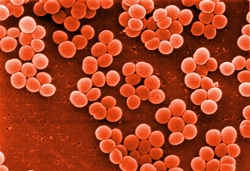Staph

Now we've all heard about the big, scary viruses such as HIV (Human Immunodeficiency Virus), HBV (Hepatitis B), HCV (Hepatitis C), and TB (Tuberculosis). Did you know that there is another wonderful little tyrant out there called Staphylococcus? It is a group of bacteria that can cause a number of diseases as a result of infection of various tissues of the body. Staphylococcus is more familiarly known as Staph (pronounced "staff"). Staph-related illness can range from mild and requiring no treatment to severe and potentially fatal. While HIV cannot live outside the human body for more than fifteen minutes in a scientifically controlled environment, Staph can hang out for days, even weeks if the environment is friendly to it. (9.) It is much more like Hepatitis B in that way (10.) and it can live longer than HCV (11.).
Let's learn a little bit about staph. I'll be citing sources and giving links to reputable sites so that you can do more research on your own if you'd like. Before we get to that though understand this: a tattoo is a controlled abrasion. It is an opening in your skin that makes you susceptible to microorganisms and bacteria by creating an opening in your body's first line of defense, your skin. This is why reading, understanding, and following our aftercare to the point is so important, and even then there is still a risk. There is always a risk, that is part of living. That being said, let's continue.
Typical Staph is one of the most common causes of skin infections in the United States. It is such a common infection for people to get that Michigan does not even include it in it's reportable diseases list unless it is the form of toxic shock syndrome. (1, 8) VRSA (Vancomycin Resistant Staphylococcus Aureus) is reportable and even worse than MRSA (Methicillin Resistant Staphylococcus Aureus) since vancomycin is generally used to treat MRSA.
Over 30 different types of Staphylococci can infect humans, but most infections are caused by Staphylococcus aureus. Staphylococci can be found normally in the nose and on the skin (and less commonly in other locations) of 25%-30% of healthy adults. In the majority of cases, the bacteria do not cause disease. However, damage to the skin or other injury may allow the bacteria to overcome the natural protective mechanisms of the body, leading to infection.
Anyone can develop a Staph infection, although certain groups of people are at greater risk, including newborn infants, breastfeeding women, and people with chronic conditions such as diabetes, cancer, vascular disease, and lung disease. Injecting drug users, those with skin injuries or disorders, intravenous catheters, surgical incisions, and those with a weakened immune system all have an increased risk of developing Staph infections. (3.)
Staphylococcus aureus causes infections (pronounced “staff infections”), including:
Skin infections
Pneumonia
Food poisoning
Toxic shock syndrome
Blood poisoning (bacteremia)
Skin infections are the most common. They can look like pimples or boils. They may be red, swollen and painful, and sometimes have pus or other drainage. They can turn into impetigo, which turns into a crust on the skin, or cellulitis, a swollen, red area of skin that feels hot.
The best way to prevent staph is to keep hands and wounds clean. Most staph skin infections are easily treated with antibiotics or by draining the infection. Some staph bacteria are resistant to certain antibiotics, making infections harder to treat.(2)
Animals and insects are also capable of carrying this bacteria. (4,7) It is important to wash your hands with antibacterial soap before touching around your tattoo after touching pets, or other animals, and try to keep insects off from any open wound. Hand washing is one of the most important ways to prevent the spread of bacteria. It seems like such a silly thing, but if you touch something with the bacteria on it and then touch a wound there is a chance for transferal. This is why our aftercare has always stated that you should do this.
Did you know that approximately 40 to 70% of health care providers carry some form of staph? (5,6) There seems to be quite a fluctuation between regions. There have also been tests done on purses showing that they can carry staph. (12.,13.)
So now that we've scared the hell out of you. Know this, staph is pretty much everywhere (14.), oh wait a minute, that's not comforting at all. The point being that we do everything that we can, short of donning full surgical gear and having us all go through a decontamination chamber, to keep you protected from that risk on our end. We undergo blood borne pathogens training, avoid cross contamination by separating work surfaces, cleaning any surfaces touched or used during the procedure once it is completed (including our hands before and after), we use sterile equipment, we ensure that our sterilizing equipment is functioning properly, and inform you of the possible risks involved in getting a tattoo or piercing. If you made it this far thank you for your time and we hope that this helps anyone out there that is confused or wanting to learn.
Later Days,
Ray
See also:
http://www.mayoclinic.com/health/staph-infections/DS00973/METHOD=print
http://cid.oxfordjournals.org/content/48/Supplement_4/S231.full
references:
1. http://www.michigan.gov/documents/mdch/2009_CDEpiProfile_337815_7.pdf
2. http://www.nlm.nih.gov/medlineplus/staphylococcalinfections.html#cat57
3. http://www.medicinenet.com/staph_infection/article.htm
4. http://www.aphis.usda.gov/animal_health/emergingissues/downloads/mrsa_122007.pdf
5. http://www.ncbi.nlm.nih.gov/pubmed/20426580
6. http://www.biolmedonline.com/Articles/MAASCON-1/Vol3_2_182-186.pdf
7. http://www.wzzm13.com/news/article/165315/9/Bed-bugs-might-carry-new-super-bug
8. http://www.michigan.gov/documents/Reportable_Disease_Chart_2005_122678_7.pdf
9. http://www.staph-infection-resources.com/faq.html#surfaces
10. http://www.cdc.gov/hepatitis/b/bfaq.htm
11. http://www.cdc.gov/hepatitis/c/cfaq.htm
12. http://www.kltv.com/Global/story.asp?S=6152338
13. http://www.wilx.com/news/headlines/7653342.html
14. http://today.msnbc.msn.com/id/21423163/ns/today-today_health/t/soap-germiest-places-your-life/



















